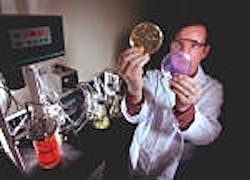FBI Names Top Scientists for Advisory Panel on Germs
Caught off guard by the anthrax attacks two years ago, the FBI has formed a scientific brain trust to help find new ways to track down germ attackers, reports William J. Broad of The New York Times.
The advisory board of about 35 members includes academic stars, as well as top federal scientists with expertise in biology, chemistry, physics and forensics, the application of science to legal cases.
"If you want to do a good job, you go to the best," the chairman of the panel, Bruce Budowle, a senior FBI scientist, said. "They see this as an important issue and want to help."
The Federal Bureau of Investigation, Dr. Budowle said in an interview with Broad, has never before gathered such a diverse body of scientific advisory talent or taken on a hard scientific job like pinpointing when and where a germ weapon was made. The bureau once had a reputation for shoddy or even faulty science but has worked hard at improving its work.
The new group is aiding the effort to advance the new science of microbial forensics, which studies deadly germs usually invisible to the human eye. It seeks to identify where a living weapon arose by analyzing its signature features and tracing it back to a particular nation, region, laboratory or microbe dish.
Today, the brain trust makes its public debut in Science magazine, where Dr. Budowle of the FBI and eight members of the advisory body discuss some of its work, goals and techniques.
Dr. Budowle said that the names of some members were not being released because they worked for sensitive arms of the government.
With these experts added, new methods for investigating deadly germs promise to produce significant new leverage in helping investigators track when and where biological weapons were made.
For instance, scientists at the University of Utah have developed a way to zero in on a rare oxygen isotope, oxygen 18, a form of the element that has two extra neutrons in its nucleus.
In lakes, rivers and water supplies across the nation, oxygen 18 occurs in differing concentrations, with maps showing its variable presence as colorful contour bands. More oxygen 18 occurs in sea water than fresh water, so rain and snow near coastlines tend to have more of it because it is heavier than oxygen 16 and falls out sooner.
Helen Kreuzer-Martin, a leader of the Utah research, said that laboratory investigations of deadly germs like anthrax could disclose the oxygen 18 taken from local waters and that those readings could be matched to contour maps to help pinpoint the growth location.
In a blind test published in the Proceedings of the National Academy of Sciences in February, the team examined oxygen 18 signatures to identify four areas, Baton Rogue, La.; Columbus, Ohio; Los Alamos, N.M.; and Salt Lake City, where colleagues had grown benign cousins of anthrax.
Source: The New York Times
